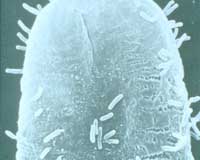| . |  |
. |
Portland, OR (UPI) Apr 02, 2010 U.S. medical scientists say they've discovered how a virus can repeatedly infect people despite a strong and long-lasting immune response. Researchers at the Oregon Health & Science University's Vaccine and Gene Therapy Institute said their study focused on the cytomegalovirus, known as CMV, which infects up to 80 percent of the U.S. population before age 40. "CMV is one of a few virus types that can efficiently reinfect individuals who are already persistently infected by this virus," Dr. Louis Picker, the institute's associate director, said. "When most viruses infect a host, the immune system remembers the disease and protects against reinfection," Picker said, explaining that's why vaccines made with weakened or dead viruses work against such pathogens. "This research explains how CMV is able to overcome this immune response so that reinfection occurs." The scientists studied monkeys naturally infected with CMV and discovered reinfection can only take place when the virus is able to evade a key portion of the immune system involving T cells, which attack and kill infected cells by identifying them by the presence of certain molecules on an infected cell's surface. The scientists discovered CMV evades those T cell systems by disrupting the molecules' ability to communicate an infection to the T cells. The study that included Professor Klaus Frueh appears in the early online edition of the journal Science.
Share This Article With Planet Earth
Related Links Epidemics on Earth - Bird Flu, HIV/AIDS, Ebola
 How Immune Cells 'Sniff Out' Bacteria
How Immune Cells 'Sniff Out' BacteriaLondon, UK (SPX) Apr 01, 2010 Scientists are learning how our immune system senses and tracks down infection in the body by responding to chemical "scents" emitted by bacteria. Studying how immune cells manipulate their movement in response to external signals could shed light not only on how our immune system functions but also how cancer cells spread through the body and even how the brain wires itself. Speaking at t ... read more |
|
| The content herein, unless otherwise known to be public domain, are Copyright 1995-2010 - SpaceDaily. AFP and UPI Wire Stories are copyright Agence France-Presse and United Press International. ESA Portal Reports are copyright European Space Agency. All NASA sourced material is public domain. Additional copyrights may apply in whole or part to other bona fide parties. Advertising does not imply endorsement,agreement or approval of any opinions, statements or information provided by SpaceDaily on any Web page published or hosted by SpaceDaily. Privacy Statement |